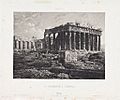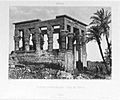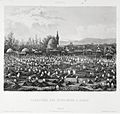Pierre-Gustave Joly de Lotbinière facts for kids
Pierre-Gustave-Gaspard Joly de Lotbinière (born February 5, 1798 – died June 8, 1865) was a French businessman and an early photographer. He was born in Switzerland and was a citizen of Geneva. He married a Canadian lady who owned a large piece of land called a seigneury.
Pierre-Gustave is famous for being the first person to take photos of the ancient Acropolis of Athens in Greece. He also photographed some old Egyptian monuments. He was the father of Sir Henri-Gustave Joly de Lotbinière, who later became the Prime Minister of Quebec from 1878 to 1879.
Contents
About Pierre-Gustave Joly
His Early Life and Family
Pierre-Gustave Joly was the son of Antoine Joly de Marval, a merchant, and Ursula Fehr de Brunner. In the early 1800s, his family moved to Épernay in Champagne, France. There, they focused on selling wine. While his father and older brother stayed in Épernay, Pierre-Gustave traveled widely. He looked for new buyers across Europe, including Germany, Poland, Russia, and Sweden. He even crossed the Atlantic Ocean to visit the United States and Canada.
In Canada, he met Julie-Christine Chartier de Lotbinière. They married in Montreal on December 17, 1828. Julie-Christine's father was Michel-Eustache-Gaspard-Alain Chartier de Lotbinière. As part of her marriage gift, she brought the seigneury of Lotbinière, which was near Quebec City. After his wedding, Pierre-Gustave started using "de Lotbinière" as part of his family name.
The couple lived in Épernay for two years. Their first son, Henri-Gustave, was born there in 1829. In 1830, they moved to Lotbinière. Pierre-Gustave managed his wife's property and his own investments. He had investments in French Guiana and in Canadian railroads. He also traveled to France sometimes.
His Travels and Photography
In 1839, Pierre-Gustave was in Paris when Louis Daguerre showed his new photography method to the world. This method was called daguerreotype. Pierre-Gustave was planning a trip to the Middle East. He bought one of the very first daguerreotype cameras from Noël Paymal Lerebours. He wanted to take pictures of the ancient buildings he would see on his journey.
He traveled through Malta to Greece, visiting Athens and other places. Then he went to Alexandria, Egypt. There, he met the painter Horace Vernet and his nephew, Frédéric Goupil-Fesquet. They also had daguerreotype cameras. The three men explored parts of Egypt together before going their separate ways.
Joly then traveled to the Holy Land, Syria, and Turkey. When he returned to Paris, five of his 92 photos were published. They appeared in a book by Lerebours called Excursions daguerriennes (1840–41). Other photos were used by architect Hector Horeau for his book Panorama from Egypt and Nubia (1841). Back then, original daguerreotypes could not be printed directly. Instead, artists made engravings from them, which could then be printed. None of Joly's original photo plates have been found, so they might be lost. We know what his photos showed from his diary, which was published in 2011.
Later Years
After his travels, Pierre-Gustave returned to his family in Quebec. He is not known to have taken any more photographs after this trip. Instead, Joly built a summer home at Pointe-Platon near Sainte-Croix. This estate is now known as Domaine Joly-De Lotbinière. It is listed as one of Canada's Historic Places.
In 1861, after 33 years of marriage, Joly separated from his wife. The year before, his wife had given the seigneury of Lotbinière to their oldest son, Henri-Gustave. Pierre-Gustave went back to Paris, France. He died there in 1865 and was buried in the Montmartre Cemetery. His wife died in Quebec on October 24, 1887, at age 77. She outlived her husband by many years and was buried at Vaudreuil.
His Children
Pierre-Gustave and Julie-Christine had three children: one daughter and two sons.
Their oldest son, Sir Henri-Gustave Joly, became an important politician. He served as the Premier of Quebec and later as the Lieutenant-Governor of British Columbia. Henri-Gustave inherited the seigneury of Lotbinière from his mother in 1860. He also inherited the family estate of Pointe Platon. In 1888, he officially added "de Lotbinière" to his name by an Act of Parliament. Queen Victoria made him a K.C.M.G. (a special honor) in 1895.
His daughter, Amelie-Ursule Joly, married Captain Henry George Savage. Their daughter, Alice, later became the Vicomtesse de Coux after marrying Alfred Aimé Etienne Michel de Coux.
His son, Edmond Joly, joined the army. He was part of the 32nd Regiment. While on sick leave, he volunteered to serve in the Crimea. He was with the Connaught Rangers during the Siege of Sevastopol (1854–1855). In 1857, he went to India to rejoin his old regiment. Edmond Joly was killed at the Siege of Lucknow on September 25, 1857.
Images for kids
-
The Parthenon, Athens, in October, 1839
-
The Temple of Olympian Zeus, Athens, in October, 1839
-
Bab al-Saghir cemetery, Damascus, in March, 1840
Other Sources
- Eleanor Brown, The world's first daguerreotype images : Canadian travel photographer Pierre Gustave Gaspard Joly de Lotbinière, in The Archivist n°118, November 1999, pp. 22–29.
- Hazen Sise, The Seigneur of Lotbinière - His "Excursions daguerriennes", Canadian Art, 1951, Vol. IX, no 1.








